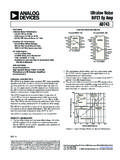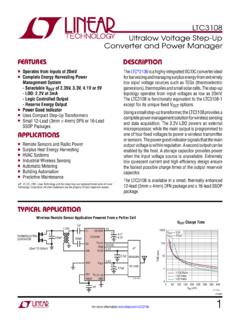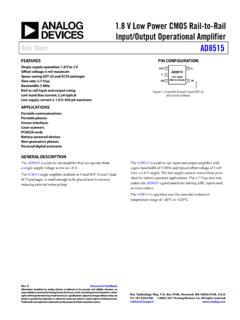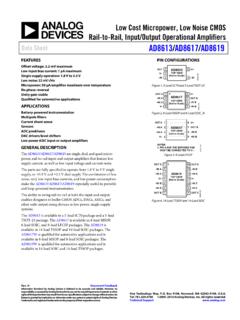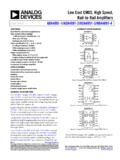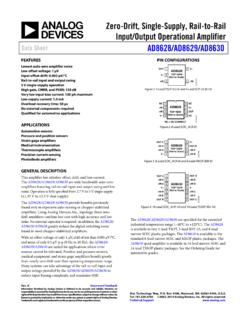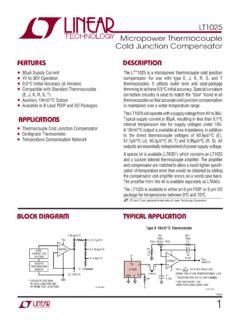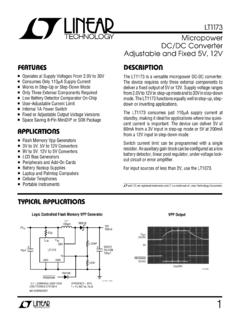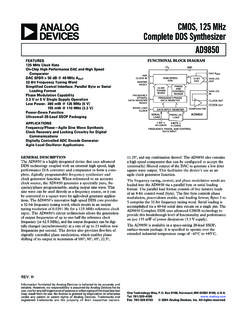Transcription of MT-088: Analog Switches and Multiplexers Basics
1 , 10/08, WK Page 1 of 23 MT-088 TUTORIAL Analog Switches and Multiplexers Basics INTRODUCTION Solid-state Analog Switches and Multiplexers have become an essential component in the design of electronic systems which require the ability to control and select a specified transmission path for an Analog signal. These devices are used in a wide variety of applications including multi-channel data acquisition systems, process control, instrumentation, video systems, etc. Switches and Multiplexers of the late 1960s were designed with discrete MOSFET devices and were manufactured in small PC boards or modules.
2 With the development of CMOS processes (yielding good PMOS and NMOS transistors on the same substrate), Switches and Multiplexers rapidly gravitated to integrated circuit form in the mid-1970s, with product introductions such as the Analog Devices' popular AD7500-series (introduced in 1973). A dielectrically-isolated family of these parts introduced in 1976 allowed input overvoltages of 25 V (beyond the supply rails) and was insensitive to latch-up. These early CMOS Switches and Multiplexers were typically designed to handle signal levels up to 10 V while operating on 15-V supplies.
3 In 1979, Analog Devices introduced the popular ADG200-series of Switches and Multiplexers , and in 1988 the ADG201-series was introduced which was fabricated on a proprietary linear-compatible CMOS process (LC2 MOS). These devices allowed input signals to 15 V when operating on 15-V supplies. A large number of Switches and Multiplexers were introduced in the 1980s and 1990s, with the trend toward lower on-resistance, faster switching, lower supply voltages, lower cost, lower power, and smaller surface-mount packages.
4 Today, Analog Switches and Multiplexers are available in a wide variety of configurations, options, etc., to suit nearly all applications. On-resistances less than , picoampere leakage currents, signal bandwidths greater than 1 GHz, and single supply operation are now possible with modern CMOS technology. Industrial products are also available which operate on 15 V supplies using Analog Devices' iCMOS (industrial CMOS) process. Although CMOS is by far the most popular IC process today for Switches and Multiplexers , bipolar processes (with JFETs) and complementary bipolar processes (also with JFET capability) are often used for special applications such as video switching and multiplexing where the high performance characteristics required are not attainable with CMOS.
5 Traditional CMOS Switches and Multiplexers suffer from several disadvantages at video frequencies. Their switching time is generally not fast enough, and they require external buffering in order to drive typical video loads. In addition, the small variation of the CMOS switch on-resistance with signal level (RON modulation) can introduce unwanted distortion in differential gain and phase. Multiplexers based on complementary bipolar technology offer better solutions at video frequencies with obvious power and cost increases above CMOS devices.
6 MT-088 CMOS SWITCH Basics The ideal Analog switch has no on-resistance, infinite off-impedance and zero time delay, and can handle large signal and common-mode voltages. Real CMOS Analog Switches meet none of these criteria, but if we understand the limitations of Analog Switches , most of these limitations can be overcome. CMOS Switches have an excellent combination of attributes. In its most basic form, the MOSFET transistor is a voltage-controlled resistor.
7 In the "on" state, its resistance can be less than 1 , while in the "off" state, the resistance increases to several hundreds of megohms, with picoampere leakage currents. CMOS technology is compatible with logic circuitry and can be densely packed in an IC. Its fast switching characteristics are well controlled with minimum circuit parasitics. MOSFET transistors are bilateral. That is, they can switch positive and negative voltages and conduct positive and negative currents with equal ease.
8 A MOSFET transistor has a voltage controlled resistance which varies nonlinearly with signal voltage as shown in Figure 1. ALTERNATE SYMBOLSPMOSNMOS Figure 1: MOSFET Switch ON-Resistance Versus Signal Voltage The complementary-MOS process (CMOS) yields good P-channel and N-channel MOSFETs. Connecting the PMOS and NMOS devices in parallel forms the basic bilateral CMOS switch of Figure 2. This combination reduces the on-resistance, and also produces a resistance which varies much less with signal voltage.
9 Page 2 of 23 MT-088 SWITCHDRIVERSWITCHF igure 2: Basic CMOS Switch Uses Complementary Pair to Minimize RON Variation due to Signal Swings Figure 3 shows the on-resistance changing with channel voltage for both N-type and P-type devices. This nonlinear resistance can causes errors in dc accuracy as well as ac distortion. The bilateral CMOS switch solves this problem. On-resistance is minimized, and linearity is also improved. The bottom curve of Figure 3 shows the improved flatness of the on-resistance characteristic of the switch.
10 COMBINED TRANSFERFUNCTION Figure 3: CMOS Switch ON-Resistance Versus Signal Voltage The ADG8xx-series of CMOS Switches are specifically designed for less than on- resistance and are fabricated on a sub-micron process. These devices can carry currents up to 400 mA, operate on a single V to V supply (depending on the particular device), and are rated over an extended temperature range of 40 C to +125 C. Typical on-resistance over temperature and input signal level is shown in Figure 4. Page 3 of 23 MT-088 INPUT SIGNAL LEVEL - VFigure 4: ON-Resistance Versus Input Signal for ADG801/ADG802 CMOS Switch, VDD = +5 V ERROR SOURCES IN THE BASIC CMOS SWITCH It is important to understand the error sources in an Analog switch.
